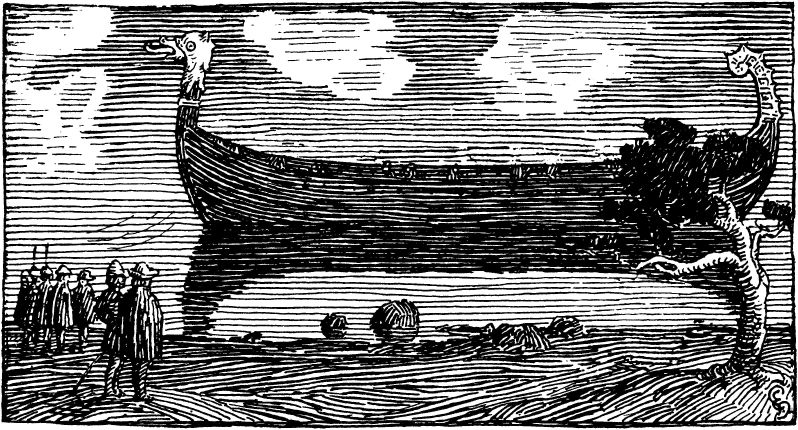Long Serpent on:
[Wikipedia]
[Google]
[Amazon]
 Ormrinn Langi in Old Norse (; ; ) was one of the most famous of the
Ormrinn Langi in Old Norse (; ; ) was one of the most famous of the
 Ormrinn Langi in Old Norse (; ; ) was one of the most famous of the
Ormrinn Langi in Old Norse (; ; ) was one of the most famous of the Viking
Vikings were seafaring people originally from Scandinavia (present-day Denmark, Norway, and Sweden),
who from the late 8th to the late 11th centuries raided, pirated, traded, and settled throughout parts of Europe.Roesdahl, pp. 9‚ ...
longship
Longships, a type of specialised Viking ship, Scandinavian warships, have a long history in Scandinavia, with their existence being archaeologically proven and documented from at least the fourth century BC. Originally invented and used by th ...
s. It was built for the Norwegian King Olaf Tryggvason
Olaf Tryggvason (960s ‚Äď 9 September 1000) was King of Norway from 995 to 1000. He was the son of Tryggvi Olafsson, king of Viken ( Vingulmark, and R√•nrike), and, according to later sagas, the great-grandson of Harald Fairhair, first King ...
, and was the largest and most powerful longship of its day. In the late 990s, King Olaf was on a "Crusade" around the country to bring Christianity to Norway. When he was traveling north to Hålogaland
H√•logaland was the northernmost of the Norwegian provinces in the medieval Norse sagas. In the early Viking Age, before Harald Fairhair, H√•logaland was a kingdom extending between the Namdalen valley in Tr√łndelag county and the Lyng ...
, he ended up in battle with forces of Raud the Strong
Raud the Strong was a Norse chieftain, blót practitioner and seafaring warrior, who resisted conversion to Christianity in the late 10th century AD, described in Heimskringla.
Olaf Tryggvason was King of Norway from 995 to 1000 AD. He played a ...
, who refused to convert to Christianity. Olaf eventually captured Raud, and gave him two choices: convert or die. The Sagas say that Olaf tried to convert him but Raud cursed the name of Jesus, and the King became so enraged that he, using either the hollow stalk of an angelica
''Angelica'' is a genus of about 90 species of tall Biennial plant, biennial and Perennial plant, perennial herbaceous, herbs in the family Apiaceae, native to temperate and subarctic regions of the Northern Hemisphere, reaching as far north as ...
or his horn and a red-hot iron, forced a snake down Raud's throat, which ate its way out of the side of the torso of Raud and killed him. Thereafter, Olaf confiscated Raud's riches, not least of which was Raud's ship, which he rechristened ''Ormen'' (modern Norwegian version of the name, meaning The Serpent). He took it to Trondheim and used it as a design for his own new ship, which he made a couple of "rooms" longer than Ormen and named ''Ormen Lange'' (modern Norwegian translation, meaning The Long Serpent).
The ship reportedly had 34 ''rooms'', i.e., was built with 34 pairs of oars, for a crew of 68 rowers (and additional crew members). Extrapolating from archeological evidence (e.g., the Gokstad ship
The Gokstad ship is a 9th-century Viking ship found in a burial mound at Gokstad in Sandar, Norway, Sandar, Sandefjord, Vestfold, Norway. It is displayed at the Viking Ship Museum (Oslo), Viking Ship Museum in Oslo, Norway. It is the largest pr ...
), this would make Ormen Lange nearly long. The ship's sides were unusually high, "as high as that of a Knarr
A knarr () is a type of Norse merchant ship used by the Vikings for long sea voyages and during the Viking expansion. The knarr was a cargo ship; the hull was wider, deeper and shorter than a longship, and could take more cargo and be operated ...
".
Ormen Lange was the last ship to be taken in the Battle of Svolder
The Battle of Svolder (''Svold'' or ''Swold'') was a large naval battle during the Viking age, fought in September 1000 in the western Baltic Sea between King Olaf of Norway and an alliance of the Kings of Denmark and Sweden and Olaf's enemies ...
, where Olaf was killed (although his body was never found‚ÄĒsome stories tell of the king jumping into the water either sinking due to the weight of his armour or escaping in the confusion) by a coalition of his enemies in the year 1000.
Its story is told in a traditional style Faroese ballad, or Kv√¶√įi
Kv√¶√įi are the old ballads of the Faroe Islands, accompanied by the Faroese chain dance.
They typically recite stories and can have hundreds of stanzas plus a refrain, chorus sung between every verse.
History
It is generally thought that Fa ...
, called " Ormurin Langi", albeit written around 1830 during a resurge in interest of this otherwise medieval-origin type of ballad.
References
Björn Landström
Bj√∂rn Olof August Landstr√∂m (21 April 1917, in Kuopio, Finland ‚Äď 7 January 2002, in Helsinki) was a Finland Swedish
Finland Swedish or Fenno-Swedish (; ) is a Variety (linguistics), variety of the Swedish language and a closely related gro ...
, ''The Ship: Illustrated History'' (1961)
{{Norway-mil-ship-stub
10th century in Norway
History of transport in Norway
Ships built in Trondheim
Viking ships
Ships of Norway
Medieval ships